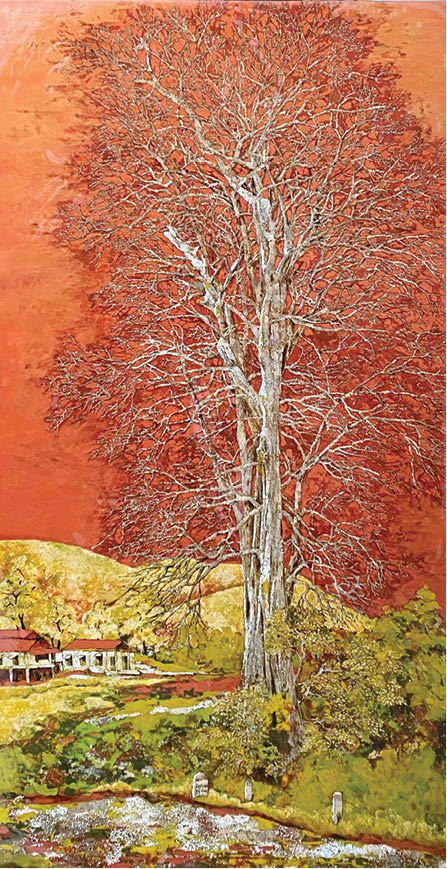
The innocence age 1
The depth of beauty
There are many paintings with deep, gentle and elegant hues on the walls at Le Phan Quoc’s house. It is difficult to describe the feeling, but Quoc’s lacquer paintings must have deeply touched the inner soul and reminded viewers of the nostalgic old days.
“Compared to Japanese lacquer paintings, Vietnamese traditional R.S. lacquer painting is much more beautiful because of the depth it brings about. Japanese lacquer is strong and brightly colored, but it does not have the inner magic like R.S. lacquer. Currently, Japanese lacquer is much more popular than Vietnam R.S lacquer because it is easy to make, quick to get dry, and strongly colored. Many painters still use Japanese lacquer for commercialized paintings, but they will choose to use R.S. lacquer if they do something creative,” Le Phan Quoc excitedly said at the beginning of the story.
After 22 years of pursuing lacquer painting, Le Phan Quoc has created more than 50 traditional lacquer paintings on the subject of landscapes and young ladies in realistic style.
“Hue has diverse landscapes which inspire creativity for many artists. For women, they are the beauty of Creator. I want my painting to be able to convey information, humanity and Vietnamese identity. I find that paintings about the traditional culture of Vietnam and different regions, our painting material, R.S. lacquer, will create intimacy, affection and depth that no other materials are able to do,” Le Phan Quoc said.
His passion brought him valuable prizes twice. He won the second prize at the 3rd Mekong Contemporary Art Competition in Thailand in 2014 with the work “Tay Bac charms”, and another second prize with the work “Innocent Age” at the 2nd Mekong Contemporary Art Contest in 2013. Recently, he won the Consolation Prize at the Exhibition of the Northern Central Region in 2022 with the work “Road to Khe Sanh” on lacquer material.
Vietnam lacquer has been internationally recognized, and Vietnam is considered to be home to lacquer painting techniques. According to Le Phan Quoc, from lacquers to decorate as home utensils, Vietnamese painters have developed and transformed it into lacquer paintings. This type of painting was initiated by Vietnamese painters before it has been developed in Thailand, Japan, and China recently. Lacquer painting is also known as the national painting of Vietnam and is very popular with foreigners. This is the reason why many artists from abroad to have come to Vietnam to learn to do lacquer paintings.

Way to Khe Sanh
Karma
Talking about his passion for lacquer paintings, Le Phan Quoc said, “Since I was a student, I have loved lacquer paintings. When I applied for a university entrance exam, I put my first choice as lacquer, and the second was also lacquered. It seems that the passion for lacquer was from the bottom of my being, so engaging in lacquer is not just a choice.”
“One of the properties of R.S. lacquer is to generate randomness. The array of colors and the color expression of R.S. lacquer are greatly diverse and attractive. This makes lacquer works dissimilar. This effect probably attracted me to the lacquer painting career,” Quoc confided.
Also extracted from succedaneum tree, Japanese lacquer is processed by modern technology, while Vietnamese succedaneum lacquer is manually prepared. Vietnam R.S. lacquer takes a long time to get dry. It takes a few days for one layer of painting to get dry before another layer is painted.
Therefore, it may take a month or so to complete a Vietnamese lacquer painting. In return, Vietnamese lacquer paintings have a durability of up to 100 years, for example those paintings by Nguyen Gia Tri, Nguyen Sang, Duong Bich Lien, etc. In the palaces of the Imperial Citadel and the mausoleums of the Nguyen Dynasty, royal illuminations remain their attractive beauty thanks to the durable R.S. lacquer material.
Lacquer painting with Vietnam R.S. lacquer material is so beautiful and elegant. However, in order to create this type of painting, it requires the artist to be patient and to have their own private creative space. They must be very passionate to pursue this artform.
Le Phan Quoc said: “The artist who composes Vietnamese lacquer paintings must have a precise concept and excess energy to create. I work on it every day, and it seems that lacquer is karma for me. If I don’t work, I feel very sad.”
“Le Phan Quoc has had in-depth research and exploitation of the traditional lacquer material at the early stage in his career. He tried to find and explore the material in new expressions. Quoc’s series of paintings on themes such as landscapes, young ladies, portraits and children come from and reflect reality. Quoc has paid attention to using lacquer’s expressive feature of intimacy and used egg shells and gold to inlay the paintings. Presumably, Quoc has created his own style for lacquer painters in Hue. His creations have not created breakthroughs, but they are just enough to make lacquer paintings familiar, expressing his innocence and attraction. This is worth due respect,” said Assoc. Prof. Dr. Phan Thanh Binh, former Rector of the College of Arts, Hue University.
Story and photos: Ngoc Ha